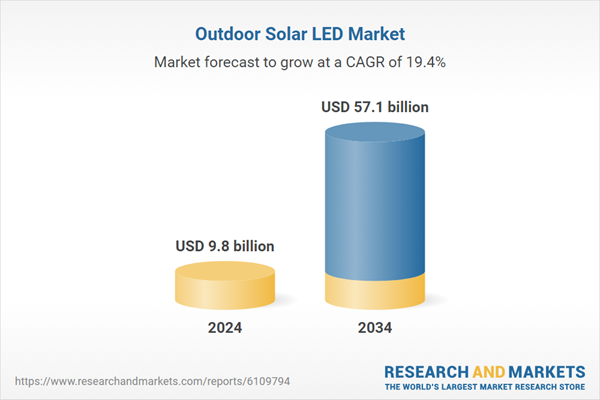These systems are being widely adopted across infrastructure and smart city developments where energy optimization is critical. In regions like the United States, energy-efficient lighting - particularly certified residential LED products - consumes significantly less power and offers drastically longer lifespan than incandescent bulbs, leading to widespread adoption among municipalities and private users. These savings are contributing to strong uptake across diverse sectors, fueling continued momentum for solar LED technologies.
Globally, governments are introducing incentives and regulatory measures to promote solar adoption. Outdoor solar LEDs are playing a key role in bringing dependable lighting to rural and underserved areas, helping improve public safety and access to basic services. They are also being integrated into national programs focused on rural electrification, emergency preparedness, and low-carbon infrastructure expansion. With public institutions increasingly adopting solar-based systems under favorable policies and financial backing, deployment is scaling quickly across both developing and developed regions.
The less than 40W segment generated USD 4.6 billion in 2024. These lower-wattage units are cost-effective, simple to install, and require minimal infrastructure, making them ideal for developing countries and regions with limited grid access. Their ability to perform well under less direct sunlight and operate with smaller panels makes them suitable for compact and shaded urban zones. They are also seeing increased usage in decorative landscaping and perimeter lighting where both design and affordability are important. As urban areas seek sustainable lighting coverage that’s cost-efficient, demand for under-40W products continues to rise across suburban and rural lighting initiatives.
Street lighting segment generated USD 4.8 billion in 2024. Street illumination is a vital part of urban development as it impacts security, transportation, and environmental goals. Expanding cities are prioritizing solar-powered street lighting as a solution to reduce energy bills and carbon emissions. These systems offer scalable and decentralized deployment, ideal for areas lacking established grid infrastructure. Features like smart dimming, motion sensors, and remote monitoring are being increasingly integrated, especially under global smart city programs. This shift is further boosting the growth of outdoor solar LEDs for roadway and public area lighting.
U.S. Outdoor Solar LED Market was valued at USD 1.9 billion in 2024, driven by broad adoption of solar lighting solutions under nationwide energy efficiency mandates and urban innovation projects. State and municipal governments are actively replacing conventional lights with solar options to lower energy expenses and carbon output. Financial support from both federal and state programs continues to fund solar lighting conversions. Additionally, heightened focus on energy resilience, particularly in areas prone to extreme weather events, is spurring demand for standalone solar LED systems that operate independently of the grid. These factors are strengthening the U.S. position as a leading and advanced market for solar LED deployment.
Notable companies in the Outdoor Solar LED Market include BISOL Group, Panasonic Holdings Corporation, Wipro Lighting, Signify Holding, and Sunna Design. To gain a competitive edge in the outdoor solar LED space, companies are prioritizing innovation, vertical integration, and global expansion. Major players are developing smart-enabled solar LED solutions featuring motion detection, wireless connectivity, and adaptive brightness to align with smart city infrastructure goals. Many firms are also focusing on enhancing the efficiency of solar panels and battery storage within their lighting systems. Strategic partnerships with municipal bodies and infrastructure firms help secure large-scale projects, particularly in emerging economies. Companies are investing in modular and scalable product lines to meet varying wattage and design needs, allowing greater customization.
Comprehensive Market Analysis and Forecast
- Industry trends, key growth drivers, challenges, future opportunities, and regulatory landscape
- Competitive landscape with Porter’s Five Forces and PESTEL analysis
- Market size, segmentation, and regional forecasts
- In-depth company profiles, business strategies, financial insights, and SWOT analysis
This product will be delivered within 2-4 business days.
Table of Contents
Companies Mentioned
- BISOL Group
- Crompton Greaves Consumer Electricals Limited
- Greenshine New Energy
- Guangzhou Anern Energy Technology Co., Ltd.
- Havells India Limited
- LEADSUN
- Panasonic Holdings Corporation
- Polybrite Solar Co., Ltd.
- Sensol Technologies
- Signify Holding
- SOKOYO Solar Lighting Co., Ltd.
- Solar Lighting International, Inc.
- Sunna Design
- Suntech-Solar-Enterprises
- URJA SAUR ELECTRONICS
- Wipro Lighting
Table Information
| Report Attribute | Details |
|---|---|
| No. of Pages | 185 |
| Published | June 2025 |
| Forecast Period | 2024 - 2034 |
| Estimated Market Value ( USD | $ 9.8 billion |
| Forecasted Market Value ( USD | $ 57.1 billion |
| Compound Annual Growth Rate | 19.4% |
| Regions Covered | Global |
| No. of Companies Mentioned | 16 |









